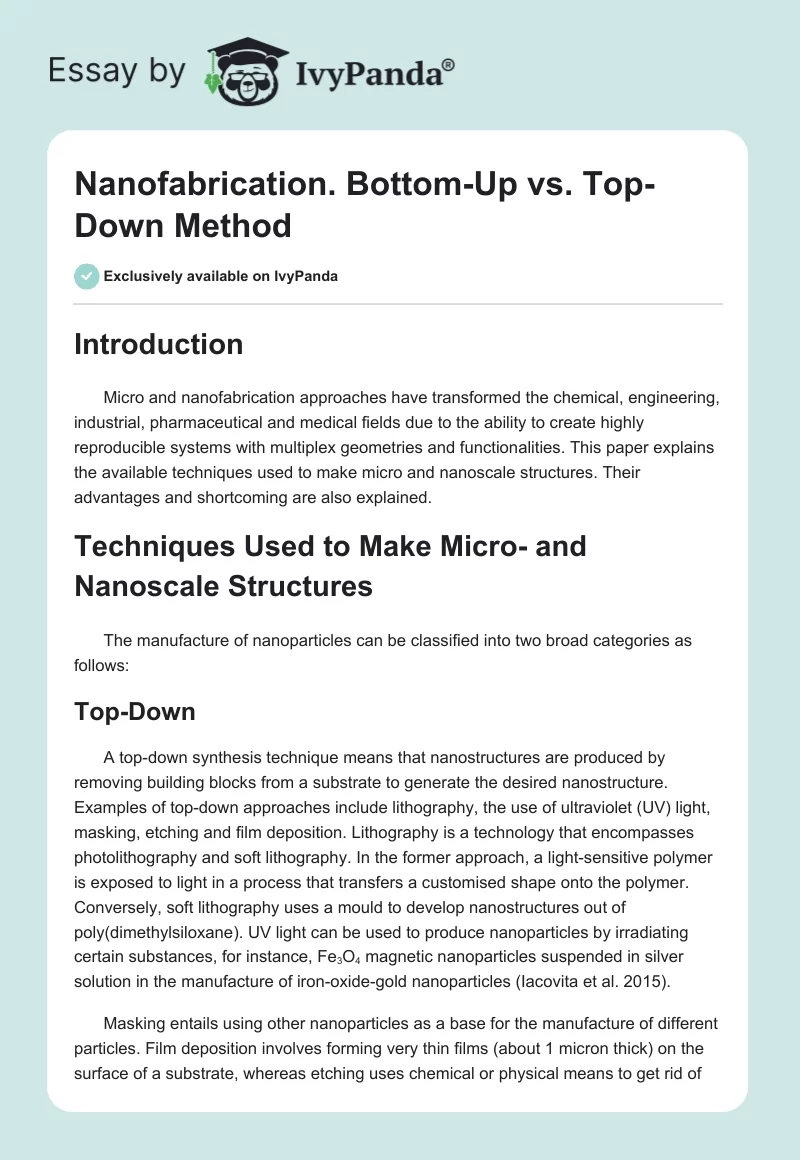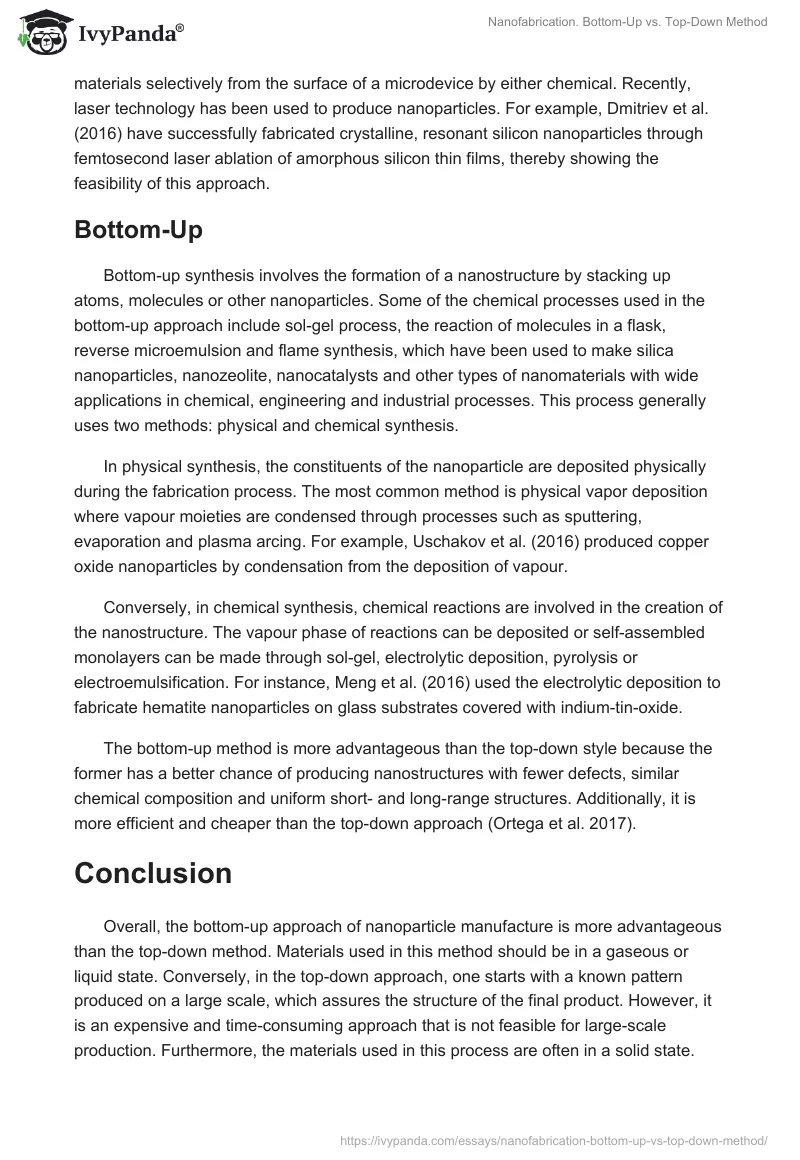Introduction
Micro and nanofabrication approaches have transformed the chemical, engineering, industrial, pharmaceutical and medical fields due to the ability to create highly reproducible systems with multiplex geometries and functionalities. This paper explains the available techniques used to make micro and nanoscale structures. Their advantages and shortcoming are also explained.
Techniques Used to Make Micro- and Nanoscale Structures
The manufacture of nanoparticles can be classified into two broad categories as follows:
Top-Down
A top-down synthesis technique means that nanostructures are produced by removing building blocks from a substrate to generate the desired nanostructure. Examples of top-down approaches include lithography, the use of ultraviolet (UV) light, masking, etching and film deposition. Lithography is a technology that encompasses photolithography and soft lithography. In the former approach, a light-sensitive polymer is exposed to light in a process that transfers a customised shape onto the polymer. Conversely, soft lithography uses a mould to develop nanostructures out of poly(dimethylsiloxane). UV light can be used to produce nanoparticles by irradiating certain substances, for instance, Fe3O4 magnetic nanoparticles suspended in silver solution in the manufacture of iron-oxide-gold nanoparticles (Iacovita et al. 2015).
Masking entails using other nanoparticles as a base for the manufacture of different particles. Film deposition involves forming very thin films (about 1 micron thick) on the surface of a substrate, whereas etching uses chemical or physical means to get rid of materials selectively from the surface of a microdevice by either chemical. Recently, laser technology has been used to produce nanoparticles. For example, Dmitriev et al. (2016) have successfully fabricated crystalline, resonant silicon nanoparticles through femtosecond laser ablation of amorphous silicon thin films, thereby showing the feasibility of this approach.
Bottom-Up
Bottom-up synthesis involves the formation of a nanostructure by stacking up atoms, molecules or other nanoparticles. Some of the chemical processes used in the bottom-up approach include sol-gel process, the reaction of molecules in a flask, reverse microemulsion and flame synthesis, which have been used to make silica nanoparticles, nanozeolite, nanocatalysts and other types of nanomaterials with wide applications in chemical, engineering and industrial processes. This process generally uses two methods: physical and chemical synthesis.
In physical synthesis, the constituents of the nanoparticle are deposited physically during the fabrication process. The most common method is physical vapor deposition where vapour moieties are condensed through processes such as sputtering, evaporation and plasma arcing. For example, Uschakov et al. (2016) produced copper oxide nanoparticles by condensation from the deposition of vapour.
Conversely, in chemical synthesis, chemical reactions are involved in the creation of the nanostructure. The vapour phase of reactions can be deposited or self-assembled monolayers can be made through sol-gel, electrolytic deposition, pyrolysis or electroemulsification. For instance, Meng et al. (2016) used the electrolytic deposition to fabricate hematite nanoparticles on glass substrates covered with indium-tin-oxide.
The bottom-up method is more advantageous than the top-down style because the former has a better chance of producing nanostructures with fewer defects, similar chemical composition and uniform short- and long-range structures. Additionally, it is more efficient and cheaper than the top-down approach (Ortega et al. 2017).
Conclusion
Overall, the bottom-up approach of nanoparticle manufacture is more advantageous than the top-down method. Materials used in this method should be in a gaseous or liquid state. Conversely, in the top-down approach, one starts with a known pattern produced on a large scale, which assures the structure of the final product. However, it is an expensive and time-consuming approach that is not feasible for large-scale production. Furthermore, the materials used in this process are often in a solid state. Consequently, it is important to consider the merits and demerits of each approach before using it to produce nanoparticles.
Reference List
Dmitriev, PA, Makarov, SV, Milichko, VA, Mukhin, IS, Gudovskikh, AS, Sitnikova, AA, Samusev, AK, Krasnok, AE & Belov, PA 2016, ‘Laser fabrication of crystalline silicon nanoresonators from an amorphous film for low-loss all-dielectric nanophotonics’, Nanoscale, vol. 8, no. 9, pp. 5043-5048.
Iacovita, C, Stiufiuc, G, Florea, A, Stiufiuc, R & Lucaciu, CM 2015, ‘Ultraviolet light assisted synthesis of magnetoplasmonic nanoparticles’, Digest Journal of Nanomaterials and Biostructures, vol. 10, no. 4, pp. 1209-1214.
Meng, Q, Wang, Z, Chai, X, Weng, Z, Ding, R & Dong, L 2016, ‘Fabrication of hematite (α-Fe2O3) nanoparticles using electrochemical deposition’, Applied Surface Science, vol. 368, pp. 303-308.
Ortega, S, Ibáñez, M, Liu, Y, Zhang, Y, Kovalenko, MV, Cadavid, D & Cabot, A 2017, ‘Bottom-up engineering of thermoelectric nanomaterials and devices from solution-processed nanoparticle building blocks’, Chemical Society Reviews, vol. 46, no. 12, pp. 3510-3528.
Uschakov, AV, Karpov, IV, Lepeshev, AA & Petrov, MI 2016, ‘Plasma-chemical synthesis of copper oxide nanoparticles in a low-pressure arc discharge’, Vacuum, vol. 133, pp. 25-30.


